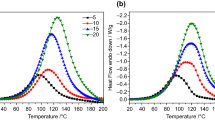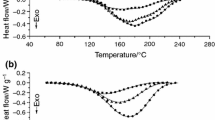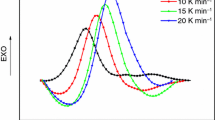Abstract
Dielectric analysis (DEA) is a well-known method used for the monitoring of curing processes in non-aqueous radical or polyadditive systems. Tests on polycondensating binders used in wood-working industry show that the method is also suited for the curing characterization of aminoplast materials. As an evaluation of the test method, a correlation with dynamic mechanical analysis (DMA)—a conventional method for curing characterization—was carried out using simultaneous measurements. For thermally cross-linked urea-formaldehyde (UF) resins, ion viscosity measured by DEA is synchronously increasing with the storage modulus determined by DMA. Significantly, deceleration effects are detectable upon using latent ionic curing agents. Model free kinetics allows the calculation of isothermal values from dynamic measurements of logarithmic ion viscosity. The correlation tests provide a basis for DEA to be established as an in situ curing characterization method for aminoplast resin systems.
Zusammenfassung
Die dielektrische Analyse (DEA) ist im Bereich von nichtwässrigen radikalischen und polyadditiven Systemen eine bekannte Methode zur Verfolgung der Vernetzung. Versuche mit in der Holzwerkstoffindustrie verwendeten, polykondensierenden Bindemitteln zeigen, dass die Methode prinzipiell auch zur Verfolgung der Vernetzung von aminoplastischen Materialien geeignet wäre. In dieser Arbeit wurde zur Verifizierung der Messmethode eine Korrelation zur dynamisch-mechanischen Analyse (DMA), einer herkömmlichen Methode der Härtungscharakterisierung, durchgeführt. Die Messungen erfolgten in einer simultanen Messeinrichtung. Bei rein thermisch vernetzten Harnstoff-Formaldehyd (UF) Harzen verläuft der Anstieg der Ionenviskosität der DEA synchron mit dem Anstieg des Speichermoduls der DMA.
Bei Verwendung latenter ionischer Härter sind Verzögerungseffekte nachweisbar. Über eine modellfreie Kinetik ist es möglich, aus dynamischen Verläufen der logarithmierten Ionenviskosität isotherme Verläufe zu ermitteln. Die Korrelationstests stellen eine Basis für eine zukünftige in situ Härtungscharakterisierung aminoplastischer Leimsysteme über die DEA dar.





Similar content being viewed by others
References
Dorner F, Wuzella G, Unterweger C, Müller U (2010) Curing control of aminoplastic resins by model-free kinetics. Holztechnologie 51:11–15
Harper DP, Wolcott MP, Rials TG (2001) Evaluating cure of a pMDI-wood bondline using spectroscopic, calorimetric and mechanical methods. J Adhes 76:55–74
Jost M, Sernek M (2009) Shear strength development of the phenol-formaldehyde adhesive bond during cure. Wood Sci Technol 43:153–166
Kandelbauer A, Wuzella G, Mahendran A, Taudes I, Widsten P (2009) Model-free kinetic analysis of melamine–formaldehyde resin cure. Chem Eng J 152:556–565
Knappe S (2002) Der Aushärtung auf der Spur, Sensorvielfalt im Labor und im Prozess. Kunstst Trends, 12
Knappe S (2003) Vernetzung verfolgen, Optimierte Lackhärtung durch dielektrische und kinetische Analyse. Farbe Lack 109:18–22
Kranbuehl D, Delos S, Hoff M, Weller L, Haverty P, Seeley J (1988) Frequency-dependent dielectric analysis. In: Dickie RA, Labana SS, Bauer RS (eds) Cross-linked polymers. ACS Symposium Series, Bd 376, S 100–112
Pretschuh C, Eckmann R, Müller U, Schwarzinger C, Schwödiauer R, Panzer U (2011) Fundamental investigation for the application of dielectric analysis as cross-linking control for aminoplast resins. Holztechnologie (accepted)
Sernek M, Kamke FA (2007) Application of dielectric analysis for monitoring the cure process of phenol formaldehyde adhesive. Int J Adhes Adhes 27:562–567
Sernek M, Kariz M (2009) Mechanical and dielectric response of thermosetting wood adhesives during cure. In: Proceedings wood adhesives, 2009, Lake Tahoe, USA
Sheppard DD, Twombly B (1996) Simultaneous dynamic mechanical analysis and dielectric analysis of polymers. Thermochim Acta 272:125–129
Vyazovkin S (1997) Evaluation of activation energy of thermally stimulated solid-state reactions under arbitrary variation of temperature. J Comput Chem 18(3):393–402
Wang S, Winistorfer PM (2003) Monitoring resin cure during particleboard manufacture using a dielectric system. Wood Fiber Sci 35(4):532–539
Zahouily K, Decker C, Kaisersberger E, Gruener M (2003) Real-time UV cure monitoring: dielectric and infrared spectroscopy analyses show close linear correlation. Eur Coat J 11:14–18
Acknowledgements
The scientific work was financed by the COMET program. The authors would like to thank for the support of the Competence Center for Wood Composites and Wood Chemistry (Wood K plus—Kompetenzzentrum Holz GmbH, Linz, Austria). Further thanks to the Institute of Polymer Chemistry of Johannes Kepler University in Linz, and to Netzsch Gerätebau GmbH for providing of measurement instruments.
Author information
Authors and Affiliations
Corresponding author
Rights and permissions
About this article
Cite this article
Pretschuh, C., Müller, U., Wuzella, G. et al. Dielectric analysis as curing control for aminoplast resins—correlation with DMA. Eur. J. Wood Prod. 70, 749–753 (2012). https://doi.org/10.1007/s00107-012-0612-0
Received:
Published:
Issue Date:
DOI: https://doi.org/10.1007/s00107-012-0612-0




